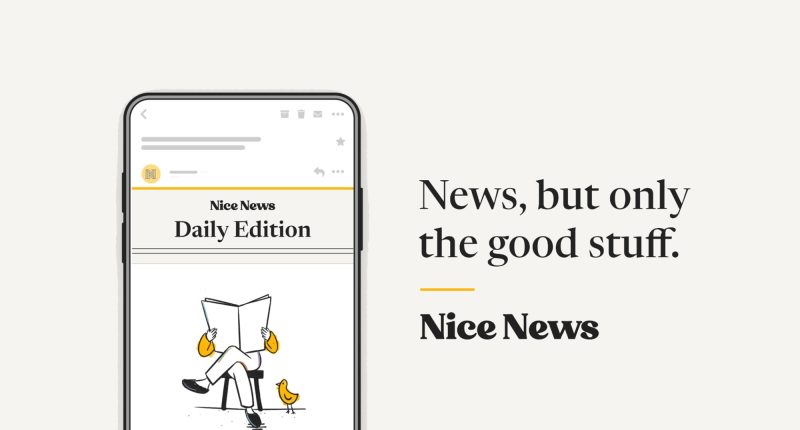
People often say they want positive news stories, but they rarely read them. Sean Devlin wanted to know: Why?
“In our initial market survey, we noticed that 81% of people weren’t familiar with any positive news platforms,” he says.
Others have tried to build positive-news brands, but with limited success. The actor John Krasinski launched a popular but short-lived YouTube series called Some Good News. But many efforts failed — like a local newspaper that once devoted a day to only positive news, and saw a 66% drop in readership.
Devlin has a newsletter-building background and wanted to see if he could crack the code. And it seems he has: His newsletter, Nice News, now has 450,000 subscribers and is building a healthy business on top of feel-good stories.
How did he do it? I discuss that with him in my podcast Problem Solvers, which you can listen to here:
1. Do your research
Devlin used to work at Optimism, previously called Inboxlab, which is an incubator for email-related concepts. (Optimism is now Nice News’s sole investor and primary shareholder.) That’s where Devlin learned the importance of research: You don’t just launch something and hope for the best — you instead understand a market and audience, and then run constant tests.
Before launching Nice News, Devlin tried to understand why positive news wasn’t more popular.
“There’s a desire for it, but is there enough good news out there for us to curate?” he wondered. “Do people feel the need to engage with this on a daily basis? What do people want to see in their inbox, and how can we make this entertaining, relevant, and enjoyable for people?”
To answer those questions, he launched Nice News and experimented with different content and formats. The newsletter is intentionally broad: Each edition features a range of positive stories from around the world — everything from scientific discoveries to feel-good local news.
To his surprise, no single subject was more popular than the other.
“People are reading the entire email and engaging with what is the most relevant and interesting to them, and it varies on a daily basis,” he says.
He also learned that positive-news consumers tend to skew female and a little older. All these insights helped him refine the product.
2. Grow smart, not wide
To grow, Nice News does a lot of what he calls “cross-pollination” — partnering with other newsletters to cross-promote each other, and sometimes even sending dedicated email campaigns to targeted user groups.
(I can attest to the power of this: Devlin ran a blurb about my newsletter in Nice News and I received 2,000 new subscribers that day.)
He also utilizes giveaways, which is a kind of promotional contest: People enter to win a prize, and when they do, they’re automatically subscribed to a newsletter.
Not everyone in the newsletter industry loves giveaways. Some say it attracts disengaged readers — because people sign up to win the prize, not because they care about the newsletter. Those people are then more liable to not open newsletters or instantly unsubscribe.
“This is a little bit misunderstood,” Devlin says. A giveaway needs to specifically target your newsletter’s ideal audience — which means your giveaway’s prize and marketing efforts must be aligned. Nice News uses the partnership marketing company DojoMojo, which helps with all that.
“So for instance, the prizing could be centered around wellness,” Devlin says. “It could be a wellness retreat. So they have an interest in the prize itself that then aligns with Nice News, because we feature content centered around health and wellness as well.”
3. Build a system (and a team to execute)
Even though Nice News delivers nice news, Devlin realized that wouldn’t be enough. It also had to be surprising and unique — to be more than just a repeat of whatever readers happened to see online.
“We realized the importance of curation, and making sure we’re uncovering these really relevant, important stories,” Devlin says.
So how do you dig through a world of difficult news, and find the most surprising, nicest gems?
He hired a small team of staff writers and editors, led by a former People magazine editor, who look through news stories decide what to feature, and write short blurbs about each.
But he also assembled a group of what he calls “freelance curators” — people who review more than 100 news sources looking for Nice News-appropriate stories. They’re based in the Philippines, which means they can search during the hours that his US-based team is asleep — which gives his staff plenty to review when they start the workday.
As a result of all this, Nice News creates a virtuous cycle: By targeting users most likely to respond to positive news, and then delivering the stories they don’t see elsewhere, the newsletter drives a lot of engagement, along with the dream of any newsletter creator — organic growth.
“Ultimately, a lot of the content that we feature is emotional,” Devlin says. “It connects with our audience to their core, and it results in them feeling compelled to share that with members of their family, of their community.”









